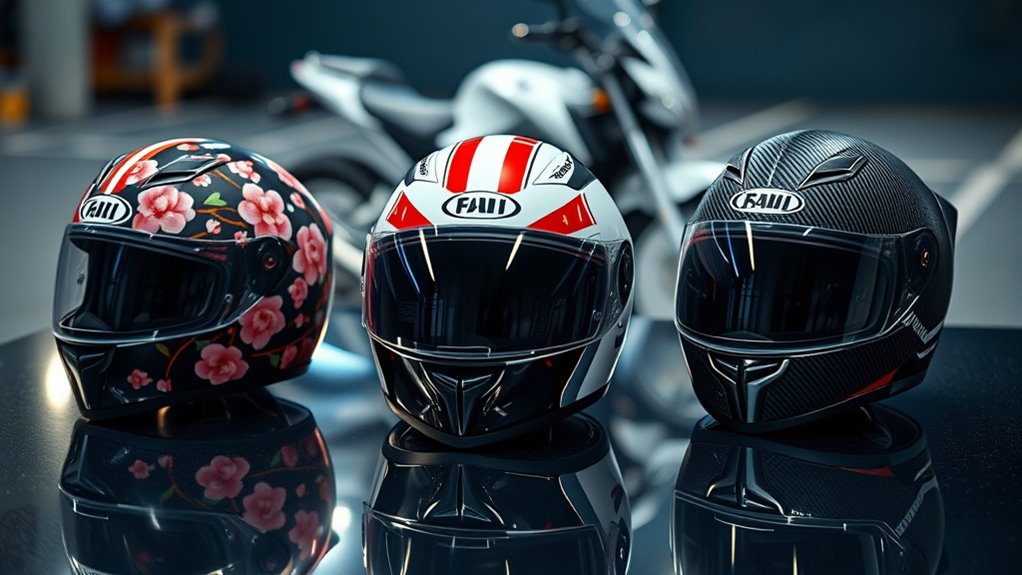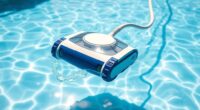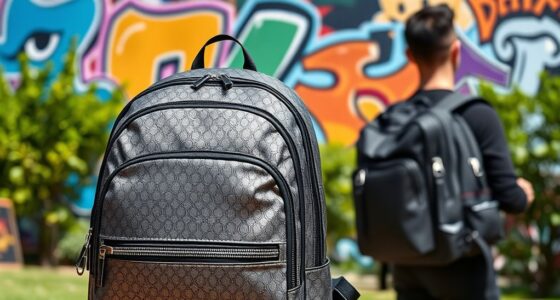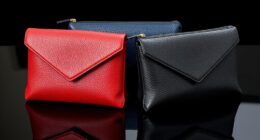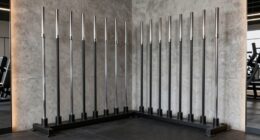Japanese helmet brands, like Arai and Shoei, blend safety and style seamlessly. You'll find helmets equipped with advanced features, such as impact protection systems and lightweight materials, ensuring comfort without compromising safety. Their designs draw inspiration from traditional art and culture, making each helmet a unique expression of identity. With options for customization, there's something for every rider. Discover how these brands stand out in the competitive market and what that means for you.
Key Takeaways
- Japanese helmet brands like Shoei and Arai prioritize safety with advanced materials and rigorous certification standards for optimal protection.
- Helmets feature innovative impact protection technologies, including rotational energy management systems to reduce harmful forces during accidents.
- Aesthetic designs draw inspiration from traditional Japanese art, allowing riders to express their individuality through vibrant graphics and custom paintwork.
- High-quality construction and comfort-focused features, such as effective ventilation systems, enhance the overall riding experience for users.
- Strong brand loyalty is cultivated through a commitment to safety, quality, and customer engagement within the motorcycle community.
Overview of Japanese Helmet Brands
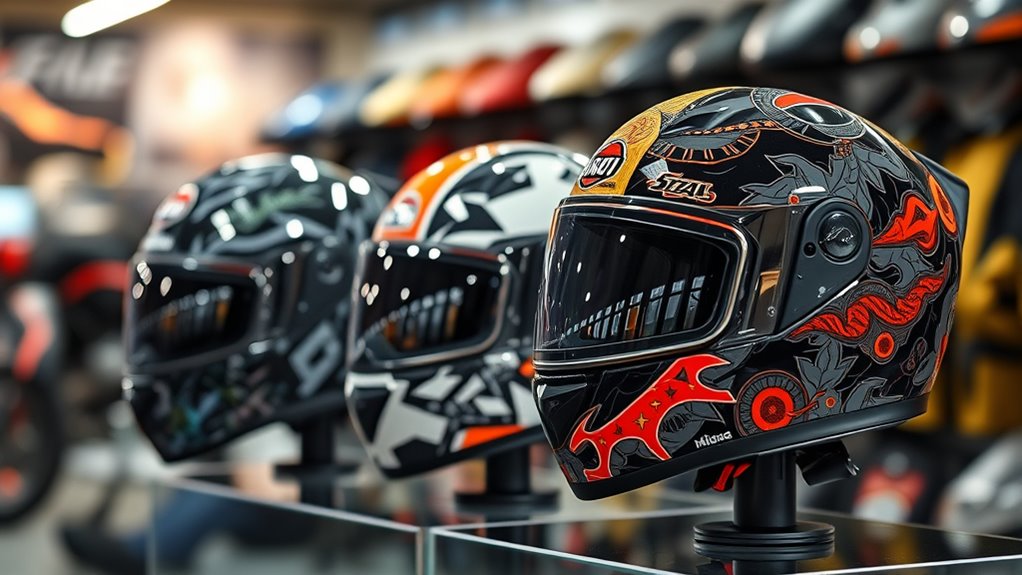
When considering helmet safety and quality, Japanese brands like Arai and OGK KABUTO stand out.
Arai Helmet Limited, founded by Hirotake Arai, has been dedicated to high-quality motorcycle helmets since shifting from cap production in 1952. The company emphasizes craftsmanship, with some helmets handcrafted in Japan, ensuring exceptional materials and safety standards. Arai helmets are designed with advanced safety features, enhancing rider protection during impacts, providing optimal performance in various riding conditions.
Arai Helmet Limited has been committed to exceptional craftsmanship and safety in motorcycle helmets since 1952.
OGK KABUTO Co., Ltd. offers a diverse range of helmets for everyone, from children to professionals, showcasing their commitment to safety and style. With a focus on innovation, they've developed over 100 kinds of helmet models.
Both brands have established a strong global presence, with Arai expanding into markets like the US and Europe, while OGK KABUTO maintains a robust presence primarily in Japan.
Key Safety Features of Japanese Helmets
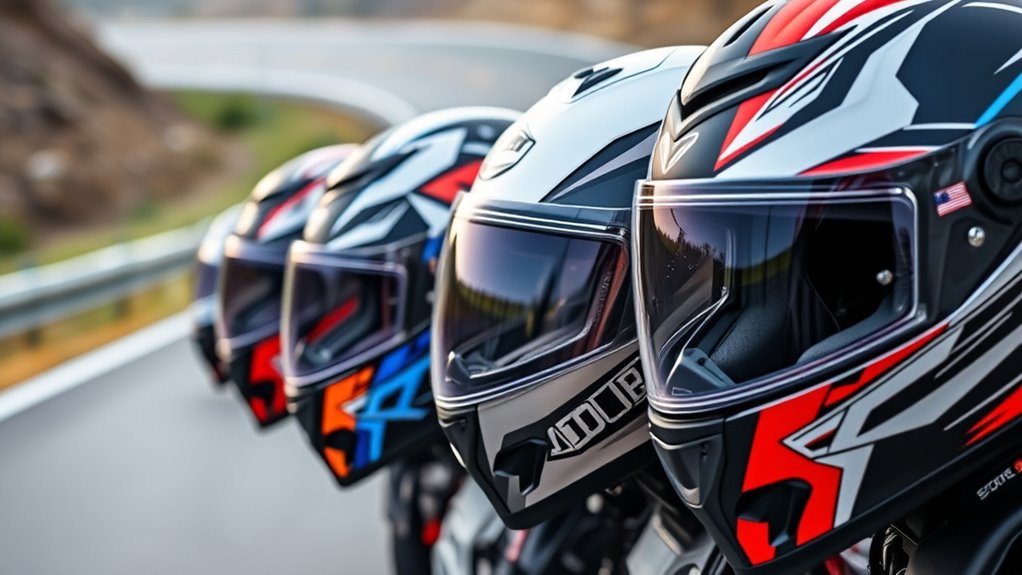
When it comes to safety, Japanese helmets stand out with advanced material technologies that enhance protection without adding weight. You'll find innovative impact protection mechanisms designed to absorb shocks and reduce injury risk. Plus, aerodynamic design features help improve stability and comfort while you ride. Additionally, helmets significantly reduce head injury risk in motorcycle accidents, further emphasizing their importance for rider safety. This emphasis on advanced material technologies ensures that riders can enjoy both safety and style on the road. Furthermore, the incorporation of fiber-rich materials in helmet construction can contribute to overall durability and strength.
Advanced Material Technologies
Japanese helmet brands utilize advanced material technologies to prioritize rider safety and comfort, making certain you get the best protection on the road.
Arai helmets feature Super Fiber, a glass fiber that's 30% stronger than standard fiberglass, while Shoei combines fiberglass with organic fibers in a fiber-reinforced matrix. Arai's meticulous resin content control maximizes fiber strength, and their precise heat and pressure management guarantees uniform shell strength. Additionally, Arai's commitment to protection ensures that every helmet is designed with the rider's safety as the top priority. Understanding the importance of zoning laws is crucial for ensuring compliance when setting up a tiny house, similar to how helmet regulations ensure rider safety. Furthermore, both brands implement integrated pest management principles in their production processes, ensuring that safety features meet high-quality standards while minimizing environmental impact.
Both brands focus on lightweight materials, enhancing overall safety without sacrificing comfort. Arai's in-house shell molding allows quick updates, and their handmade production ensures quality.
Impact Protection Mechanisms
While you ride, knowing your helmet is equipped with advanced impact protection mechanisms can greatly enhance your safety.
Japanese helmets typically feature a polystyrene foam inner shell and a hard outer shell, designed to absorb and distribute impact forces effectively. They meet rigorous certification standards like JIS, ensuring compliance with helmet standards safety regulations. Additionally, these helmets often utilize airless sprayers in their manufacturing process to achieve a smooth and durable finish. The best helmets incorporate advanced technology for better impact resistance.
The inner EPS foam crushes upon impact, considerably reducing deceleration forces on your head. Additionally, the outer shell is made from durable materials like polycarbonate or fiberglass, providing resistance against penetrating objects.
Retention systems, including secure chin straps, keep the helmet firmly in place during accidents, maximizing protection.
With these features, you can confidently enjoy your ride, knowing you're well-protected.
Aerodynamic Design Features
Helmets designed with aerodynamic features not only enhance speed but also improve overall safety during your ride.
These innovative designs utilize advanced engineering to keep you stable and comfortable. Here are four key aerodynamic features to evaluate:
- Air Tunnel Structures: These channel airflow backward, reducing drag and enhancing speed.
- Narrowed Shell Design: This shape minimizes drag in both straight and crosswind conditions. Additionally, helmets with advanced filtration systems can help reduce wind noise and improve focus while riding.
- Wake Stabilizers: Deflectors that suppress helmet lift, ensuring stability at high speeds. Additionally, helmets that incorporate energy efficiency ratings can provide better overall performance for riders.
- Spoiler Designs: They prevent helmet rise, improving your control during rides. The AERO-R2 features an Air Tunnel Structure that stabilizes aerodynamic performance and further enhances rider safety.
With these features, you can enjoy a safer and more efficient riding experience, giving you confidence on the road.
Style and Aesthetics in Helmet Design
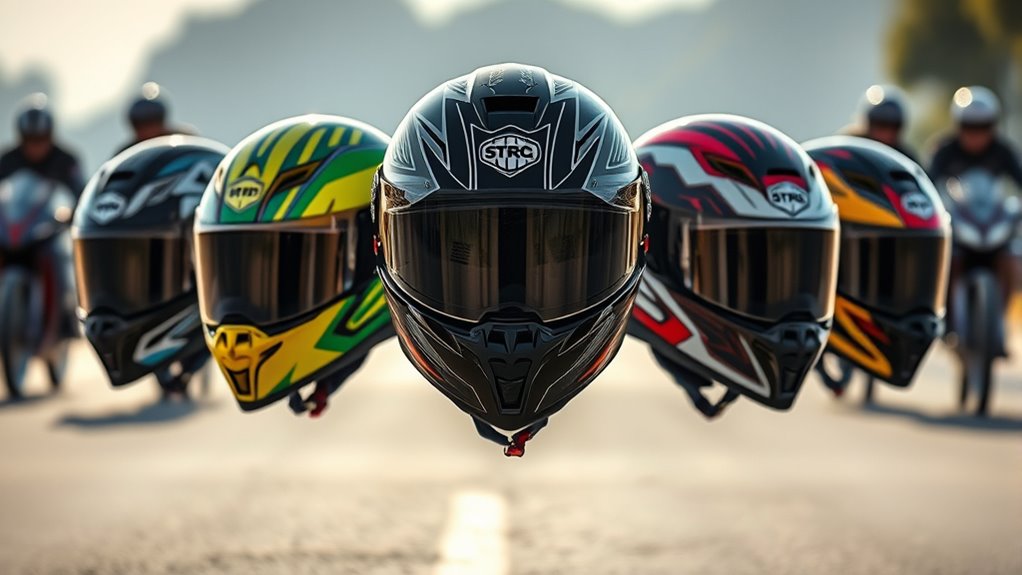
Incorporating elements of traditional art and culture, helmet design in Japan showcases a unique blend of style and aesthetics. You'll find helmets inspired by Ukiyo-e woodblock prints and samurai motifs, featuring vibrant colors and intricate designs. Each piece reflects a tribute to Japanese culture, showcasing symbolic elements like the chrysanthemum and crane. The samurai helmets symbolize strength and honor, further enhancing their appeal to riders. Additionally, the integration of mythological themes in helmet graphics connects riders to Japan's rich storytelling traditions. As with the Hopi culture, the appreciation for historical and cultural elements is evident in these designs.
| Element | Description | Example |
|---|---|---|
| Inspirational Source | Traditional art and samurai culture | Samurai-inspired graphics |
| Design Features | Vibrant colors and intricate details | Custom artwork options |
| Cultural Influence | Historical figures and mythological themes | Ukiyo-e influenced designs |
| Modern Fusion | Blending tradition with modern aesthetics | Collaborations with artists |
With customization options, riders express their individuality while honoring Japan's rich heritage.
Innovative Technology in Japanese Helmets
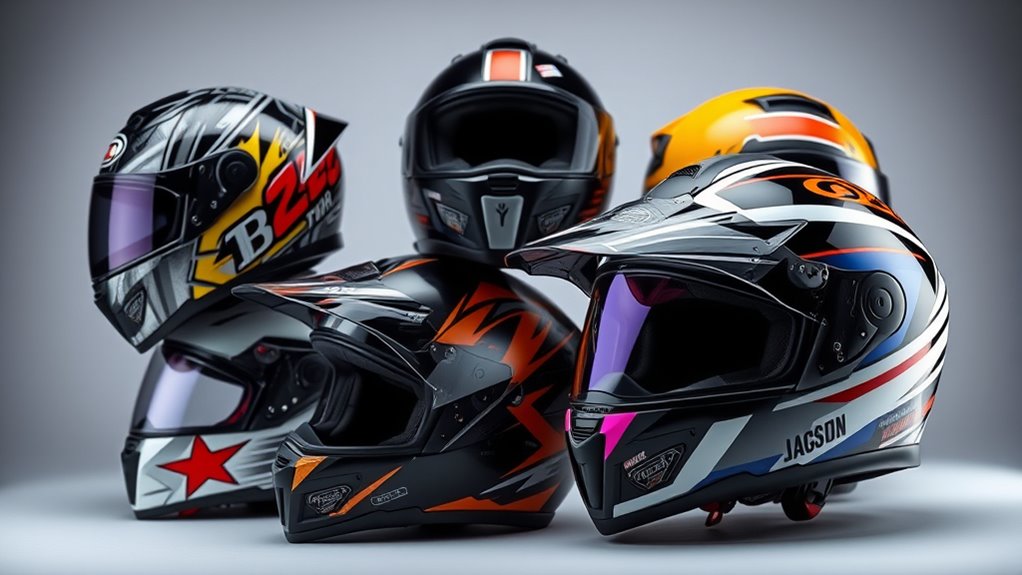
When you think about Japanese helmets, innovative technology stands out as a key feature.
From advanced materials and aerodynamic designs to integrated safety innovations, these helmets are engineered for performance and protection. The first-layer defense absorbs impact energy during a fall, enhancing rider safety. Additionally, maintaining stability through rules and routines can help ensure that riders are equipped with the best safety practices. You're not just getting a helmet; you're investing in cutting-edge technology that enhances your riding experience. Additionally, the use of strong encryption standards in helmet communication systems ensures that your data remains secure while riding.
Advanced Material Utilization
As Japanese helmet manufacturers push the boundaries of safety and comfort, they harness advanced materials and innovative technologies to create superior head protection.
You'll find that these helmets utilize:
- Super Fiber: Arai's glass fiber is 30% stronger than traditional fiberglass, enhancing durability. This innovation reflects the importance of clear communication during the development process to ensure optimal performance. Additionally, the use of antioxidants in materials can enhance the helmet's ability to withstand environmental stressors.
- Optimized Fiber Content: Arai maximizes fiber while minimizing resin, balancing weight and strength perfectly.
- 3D Max-Dry Interiors: Shoei helmets feature advanced liners that manage moisture and provide exceptional comfort.
- Customizable Fit: Multi-layer cheek pads and eyeglass channels guarantee a personalized riding experience. Furthermore, the Reevu helmet's rear visibility feature enhances safety by allowing riders to see competitors approaching from behind.
These innovations showcase the commitment to safety and comfort, making every ride enjoyable and secure.
With cutting-edge materials and manufacturing techniques, you can trust that your helmet is designed for both protection and style.
Aerodynamic Design Features
Japanese helmet manufacturers excel in aerodynamic design, ensuring you experience peak performance on the road. With innovative features like air tunnel structures, these helmets manage airflow to minimize drag. Extensive wind tunnel testing guarantees shapes that enhance your speed and stability, even in crosswinds. The Kabuto Aero-R2 Helmet is a prime example of this commitment to cutting-edge design. Continuous advancements in algorithms ensure that these designs are constantly refined for better performance. Moreover, the focus on sustainable practices in manufacturing contributes to a cleaner environment.
Here's how these designs benefit you:
| Feature | Benefit | Impact on Riding |
|---|---|---|
| Air Tunnel Structure (PAT.P) | Reduces drag | Increased speed |
| Removable Air Path Plates | Adjusts for comfort | Versatile performance |
| Narrowed Shell Design | Enhances aerodynamics | Improved handling |
| Wake Stabilizers | Suppresses turbulence | Greater stability |
| Ventilation Optimization | Maximizes airflow | Better cooling |
These features not only keep you safe but also elevate your riding experience.
Integrated Safety Innovations
While riding, you can trust that integrated safety innovations in helmets provide essential protection.
These advancements focus on keeping you safe while enhancing your riding experience. Here are some key features to look for:
- Impact Management: Enhances absorption and distribution, keeping you safer during falls. This is similar to the way hamster care emphasizes proper setup and safety for pets.
- Rotational Energy Management: Technologies like MIPS reduce harmful rotational forces on impact.
- Advanced Materials: Lightweight yet strong materials guarantee maximum protection without sacrificing comfort. Additionally, the use of HEPA filters in helmet designs can help improve air quality for riders in urban environments.
- Ventilation Systems: Innovative systems, such as Kabuto's Negative Pressure Ventilation, improve airflow and reduce fogging. Helmets are developed with a commitment to Quality of Heart, ensuring reliability and safety.
With these innovations, Japanese helmets blend cutting-edge technology with safety, guaranteeing you're well-protected on every ride.
Market Presence and Pricing Analysis
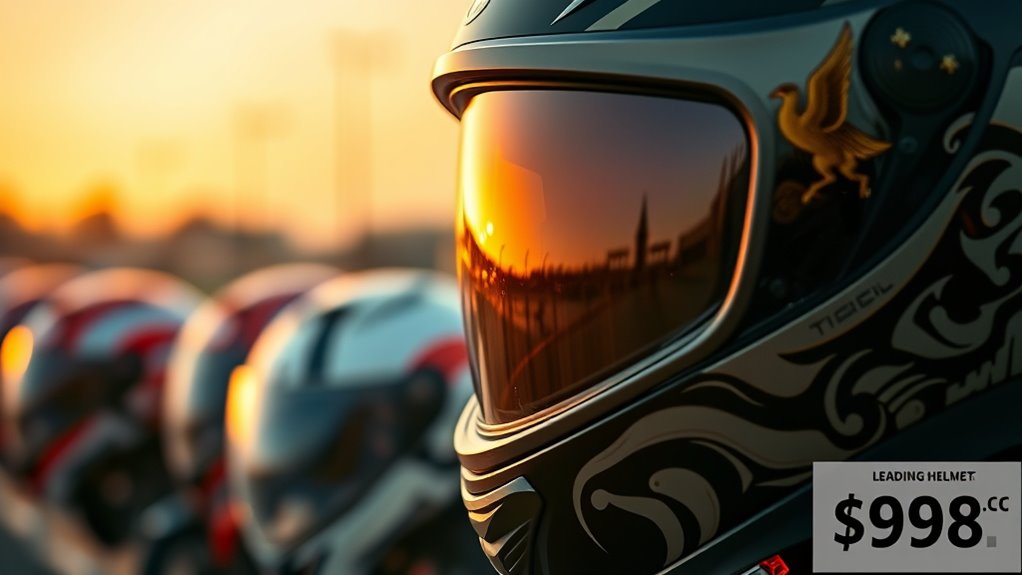
Understanding the market presence and pricing dynamics of Japanese helmet brands reveals their significant impact on the global premium motorcycle helmet landscape.
Shoei Co. dominates, holding over 60% of the market, while Arai Helmet closely competes. The premium segment is becoming more concentrated, with an HHI of 4779 in 2023. Additionally, Shoei's exceptional comfort and innovative designs contribute to its strong market position. Natural Language Processing is becoming increasingly relevant in customer interactions, influencing how brands communicate their offerings. Furthermore, brands that emphasize educational resources tend to foster greater consumer trust and loyalty.
As you explore pricing, premium helmets typically command higher costs due to advanced materials and craftsmanship. Shoei's reputation for quality justifies its premium pricing.
The global market is projected to reach USD 0.97 billion by 2025, with regional variations influenced by distribution costs and local preferences.
Europe and North America are key markets, while the Asia-Pacific region is experiencing rapid growth, driven by evolving consumer demands.
Consumer Preferences in Helmet Selection
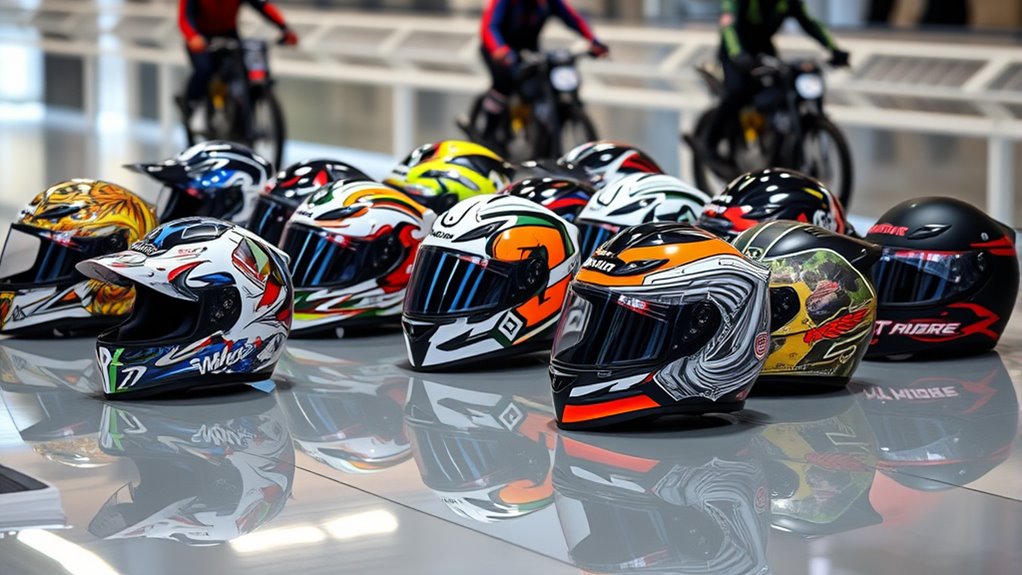
The motorcycle helmet market is shaped by various consumer preferences that greatly influence purchasing decisions.
When choosing a helmet, you likely consider:
- Safety Standards: You'll want a DOT-compliant helmet, with many prioritizing an ISI mark for reassurance.
- Comfort and Fit: A comfortable fit is vital; helmets designed for rounder heads can make a big difference, especially for individuals of Asian descent who often struggle to find suitable options in the US market.
- Ventilation Features: Good airflow is essential, especially for long rides.
- Reflective Materials: Visibility can be a lifesaver, so helmets with reflective elements catch your eye.
With these factors in mind, you're not just buying a helmet—you're investing in safety and style tailored to your riding experience.
Brand Loyalty Among Riders
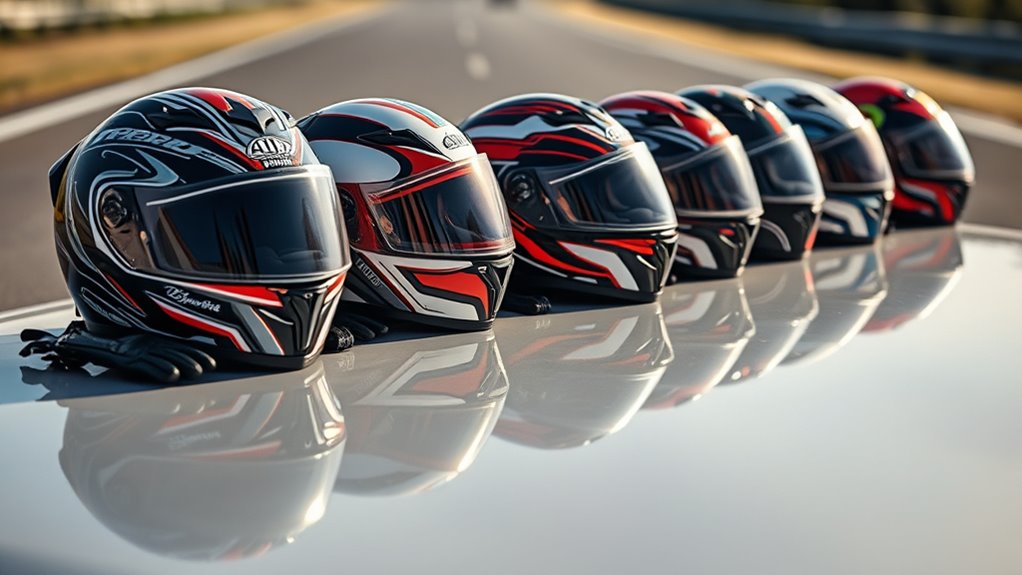
Brand loyalty among riders is often fueled by a combination of safety, quality, and personal identity. When you choose a Japanese helmet brand like Shoei or Arai, you're investing in helmets that meet stringent safety standards, ensuring your protection on the road. The high-quality materials and durable construction add to your trust in these brands. Innovative designs with features like improved ventilation and noise reduction enhance your riding experience. Additionally, the global motorcycle helmet market is projected to reach USD 4.8 billion by 2033, showcasing the growing demand for motorcycle safety gear. Plus, effective customer service and warranty options make you feel valued as a customer. With targeted marketing, these brands create strong identities that resonate with you, leading to a deep-rooted loyalty. Ultimately, your choice reflects your values and style, making your helmet brand a part of your riding identity.
Customization Options for Personalization
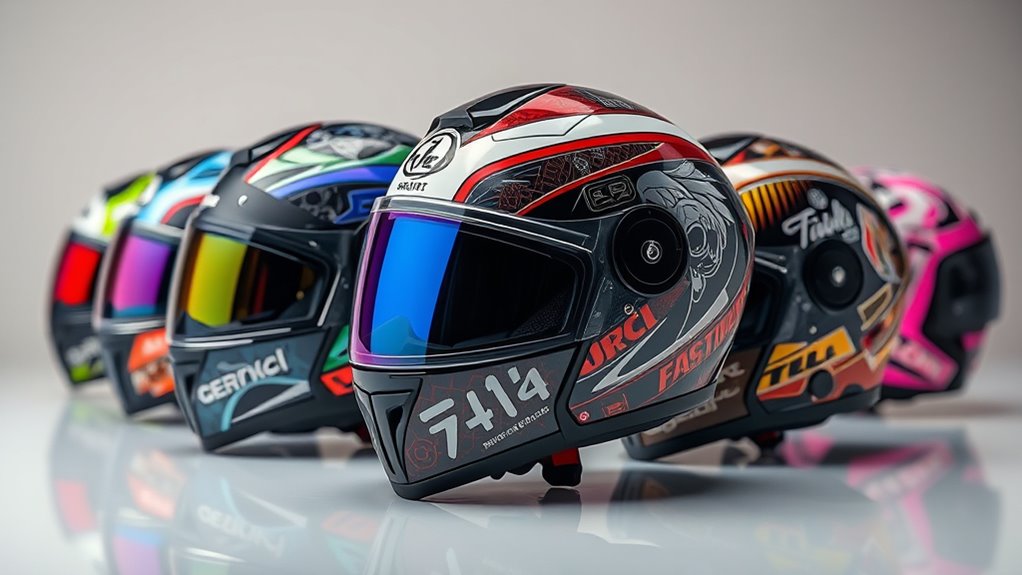
While riding, you want your helmet to reflect your personal style and identity, making customization a popular option among enthusiasts. Japanese helmet brands like Arai offer unique designs, including samurai-inspired graphics. Here are some exciting customization options you can explore:
- Custom Paintwork: Collaborate with artists to create vibrant, personalized designs.
- Samurai Graphics: Choose motifs that celebrate Japanese culture, showcasing intricate samurai art.
- Helmet Modifications: Use foam and plastic to craft distinctive shapes and styles, adding depth to your helmet.
- Artistic Collaboration: Work with customizers like Blaze Artworks to develop bespoke designs that match your vision.
Additionally, these customization options reflect the growing interest in community engagement within the motorcycle helmet market. With these options, your helmet can truly become an extension of your personality on the road.
Frequently Asked Questions
What Certifications Do Japanese Helmets Typically Have for Safety?
Japanese helmets typically have several important certifications for safety.
You'll often find JIS certification, which comes in two types: Type 1 for smaller vehicles and Type 2 for all motorcycles.
Additionally, look for PSC and SG certifications, guaranteeing compliance with local standards.
Some helmets may even have FIM approval for racing.
Always check these certifications to verify you're wearing a helmet that meets the necessary safety requirements for riding in Japan.
How Do I Choose the Right Helmet Size?
To choose the right helmet size, start by measuring your head circumference with a flexible tape measure.
Wrap it around the widest part, just above your eyebrows and ears.
Once you have your measurement, consult the manufacturer's size chart to find your match.
Pay attention to your head shape and guarantee a snug fit without discomfort.
If you're between sizes, opt for the smaller size for better safety and stability.
Can I Use a Motorcycle Helmet for Other Activities?
You can't use a motorcycle helmet for other activities without considering safety and comfort.
Motorcycle helmets are heavier and bulkier, which might hinder your performance in sports like cycling or skiing. They also lack the ventilation needed for prolonged use in those activities.
Plus, they may not meet specific safety standards required for different sports. Always choose a helmet designed for your activity to guarantee the best protection and comfort.
How Often Should I Replace My Helmet?
Think of your helmet like a trusty old friend; it's there to protect you but can't last forever.
You should replace your helmet every five years, even if you haven't had any accidents. If you see cracks, a loose liner, or if it feels uncomfortable, it's time for a new one.
Just like you wouldn't wear old shoes that hurt your feet, don't skimp on safety—your head deserves the best protection!
Are There Any Care Tips for Maintaining Helmet Quality?
To maintain your helmet's quality, start by cleaning it with mild soap and warm water using a soft cloth.
Remove the visor before cleaning to avoid scratches.
Regularly inspect the interior liner for wear and wash it gently.
Store your helmet out of direct sunlight and in a cool, dry place.
Use a helmet bag to protect it from dust.
Conclusion
As you explore the world of Japanese helmet brands, you're not just choosing safety; you're embracing a blend of style and innovation. Imagine riding with a helmet that not only protects but also reflects your personality. What if your perfect helmet is just a few clicks away, waiting to be customized to your taste? The right choice could elevate your riding experience, but the question lingers—are you ready to discover the ultimate fusion of safety and style?
